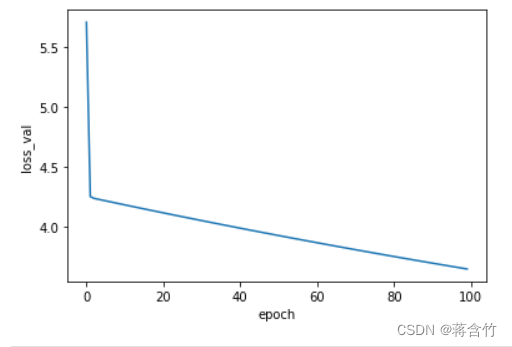PyTorch示例——LogisticRegressionModel
版本信息
- PyTorch:
1.12.1 - Python:
3.7.13
导包
import torch
import matplotlib.pyplot as plt
原始数据
X_data = torch.Tensor([[1.0, 2.9], [2.0, 6.1], [3.0, 9.2], [4.0, 12.3], [5.0, 14.9], [6.0, 18.1]])
y_data = torch.Tensor([[0], [0], [0], [1], [1], [1]])
构建模型
class MyLogisticRegressionModel(torch.nn.Module):
def __init__(self):
super(MyLogisticRegressionModel, self).__init__()
self.linear = torch.nn.Linear(2, 1)
self.logistic = torch.nn.Sigmoid()
def forward(self, x):
ouput = self.linear(x)
ouput = self.logistic(ouput)
return ouput
开始训练
learning_rate = 0.005
epoch_num = 100
my_model = MyLogisticRegressionModel()
loss = torch.nn.BCELoss(reduction='sum')
optimizer = torch.optim.SGD(my_model.parameters(), lr=learning_rate)
loss_list = []
for epoch in range(epoch_num):
y_pred = my_model(X_data)
l = loss(y_pred, y_data)
optimizer.zero_grad()
l.backward()
optimizer.step()
print(f"Train... ===> epoch = {epoch}, loss_val = {l.item()}")
loss_list.append(l.item())
Train... ===> epoch = 0, loss = 6.798981189727783
Train... ===> epoch = 1, loss = 4.380733966827393
Train... ===> epoch = 2, loss = 4.372033596038818
Train... ===> epoch = 3, loss = 4.36480188369751
Train... ===> epoch = 4, loss = 4.357597351074219
Train... ===> epoch = 5, loss = 4.350410461425781
Train... ===> epoch = 6, loss = 4.343241214752197
Train... ===> epoch = 7, loss = 4.336090087890625
Train... ===> epoch = 8, loss = 4.328956604003906
Train... ===> epoch = 9, loss = 4.321841239929199
......
Train... ===> epoch = 90, loss = 3.8016786575317383
Train... ===> epoch = 91, loss = 3.7959144115448
Train... ===> epoch = 92, loss = 3.7901651859283447
Train... ===> epoch = 93, loss = 3.7844314575195312
Train... ===> epoch = 94, loss = 3.778712272644043
Train... ===> epoch = 95, loss = 3.773008346557617
Train... ===> epoch = 96, loss = 3.7673189640045166
Train... ===> epoch = 97, loss = 3.761645555496216
Train... ===> epoch = 98, loss = 3.755985736846924
Train... ===> epoch = 99, loss = 3.7503416538238525
绘制曲线:epoch与loss
plt.plot(epochs, loss_list)
plt.xlabel("epoch")
plt.ylabel("loss_val")
plt.show()

查看权重、偏置信息
print(f"w = {my_model.linear.weight}")
print(f"b = {my_model.linear.bias}")
w = Parameter containing:
tensor([[0.1506, 0.0253]], requires_grad=True)
b = Parameter containing:
tensor([-0.0544], requires_grad=True)
利用模型做预测
X_test = torch.Tensor([[4.0, 12.0]])
y_pred = my_model(X_test)
print(f"y_pred = {y_pred.data}")
y_pred = tensor([[0.7010]])
import numpy as np
x = np.linspace(0, 10, 40)
x_t = torch.Tensor(x).view((20, 2))
y_t = my_model(x_t)
y = y_t.data.numpy()
for xe,ye in zip(x_t, y_t):
print(xe.data, '\t', ye.data)
tensor([0.0000, 0.2564]) tensor([0.4880])
tensor([0.5128, 0.7692]) tensor([0.5106])
tensor([1.0256, 1.2821]) tensor([0.5331])
tensor([1.5385, 1.7949]) tensor([0.5554])
tensor([2.0513, 2.3077]) tensor([0.5776])
tensor([2.5641, 2.8205]) tensor([0.5994])
tensor([3.0769, 3.3333]) tensor([0.6209])
tensor([3.5897, 3.8462]) tensor([0.6419])
tensor([4.1026, 4.3590]) tensor([0.6623])
tensor([4.6154, 4.8718]) tensor([0.6822])
tensor([5.1282, 5.3846]) tensor([0.7014])
tensor([5.6410, 5.8974]) tensor([0.7200])
tensor([6.1538, 6.4103]) tensor([0.7378])
tensor([6.6667, 6.9231]) tensor([0.7549])
tensor([7.1795, 7.4359]) tensor([0.7712])
tensor([7.6923, 7.9487]) tensor([0.7867])
tensor([8.2051, 8.4615]) tensor([0.8015])
tensor([8.7179, 8.9744]) tensor([0.8154])
tensor([9.2308, 9.4872]) tensor([0.8286])
tensor([ 9.7436, 10.0000]) tensor([0.8410])












 该文展示了如何在PyTorch中自定义一个LogisticRegressionModel,从构建模型、设置损失函数(BCELoss)、选择优化器(SGD)到训练过程,以及绘制训练过程中的损失(loss)随epoch变化的曲线,并最终进行预测。模型在给定的数据集上进行训练,权重和偏置在训练过程中得到更新。
该文展示了如何在PyTorch中自定义一个LogisticRegressionModel,从构建模型、设置损失函数(BCELoss)、选择优化器(SGD)到训练过程,以及绘制训练过程中的损失(loss)随epoch变化的曲线,并最终进行预测。模型在给定的数据集上进行训练,权重和偏置在训练过程中得到更新。














 1175
1175

 被折叠的 条评论
为什么被折叠?
被折叠的 条评论
为什么被折叠?








